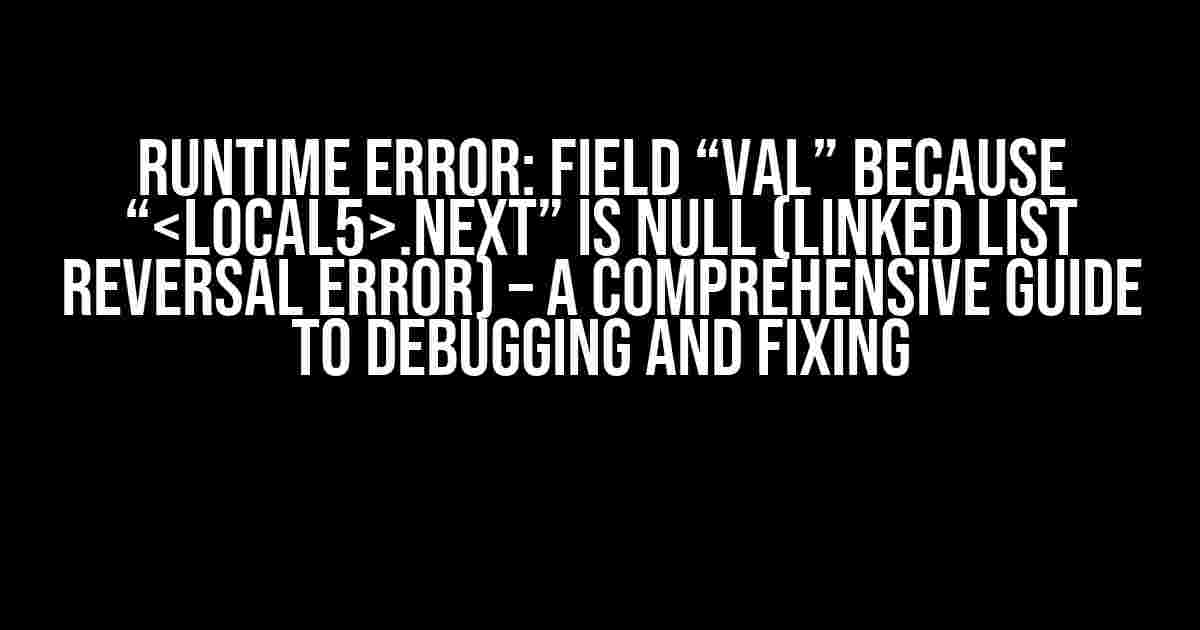If you’re reading this article, chances are you’ve encountered the frustrating “Runtime Error: field ‘val’ because ‘
Understanding the Linked List Reversal Error
A linked list is a data structure where each node points to the next node in the list. When reversing a linked list, you essentially need to change the direction of these pointers. Sounds simple, right? However, if not done correctly, it can lead to the infamous “Runtime Error: field ‘val’ because ‘
The Error Message Decoded
Let’s break down the error message to understand what’s happening:
- “Runtime Error” indicates that the error occurs during the execution of the program, rather than during compilation.
- “field ‘val'” refers to the value field of a node in the linked list.
- “because ‘
.next’ is null” means that the error is caused by trying to access the ‘next’ field of a null node, specifically the node stored in the local variable ‘ ‘.
In other words, the error occurs when the program tries to access the ‘val’ field of a node that doesn’t exist (i.e., ‘
Common Causes of the Linked List Reversal Error
1. Improper Initialization of Nodes
If nodes are not properly initialized, it can lead to null pointer exceptions. Make sure to initialize each node with a valid value and a null ‘next’ field.
2. Incorrect Reversal Algorithm
A faulty reversal algorithm can cause nodes to become null, leading to the error. Double-check your reversal logic to ensure it’s correct.
3. Null Pointer Exceptions
Uncaught null pointer exceptions can occur when trying to access fields of a null node. Use null checks to prevent these exceptions.
4. Incorrect Handling of Edge Cases
Failing to handle edge cases, such as an empty list or a list with only one node, can lead to the error. Make sure to handle these cases explicitly.
Solutions to the Linked List Reversal Error
Now that we’ve identified the common causes, let’s move on to the solutions:
1. Initialize Nodes Correctly
// Example of correct node initialization Node *node = new Node(); node->val = 5; // Assign a valid value node->next = null; // Initialize 'next' field to null
2. Implement a Correct Reversal Algorithm
// Example of a correct reversal algorithm
void reverseList(Node *&head) {
Node *prev = null;
Node *curr = head;
Node *next = null;
while (curr != null) {
next = curr->next;
curr->next = prev;
prev = curr;
curr = next;
}
head = prev;
}
3. Use Null Checks to Prevent Exceptions
// Example of using null checks
if (node != null) {
// Access node fields safely
int value = node->val;
Node *nextNode = node->next;
// ...
}
4. Handle Edge Cases Explicitly
// Example of handling edge cases
if (head == null) {
// Handle empty list
return;
}
if (head->next == null) {
// Handle list with only one node
return;
}
// Reversal logic goes here
Debugging Tips and Tricks
When debugging the linked list reversal error, keep the following tips in mind:
- Use a debugger to step through your code and identify the exact line causing the error.
- Print or log node values and ‘next’ fields to visualize the linked list structure.
- Verify that nodes are properly initialized and reversed.
- Test your code with various input scenarios, including edge cases.
Conclusion
The “Runtime Error: field ‘val’ because ‘
| Causes | Solutions |
|---|---|
| Improper initialization of nodes | Initialize nodes correctly |
| Incorrect reversal algorithm | Implement a correct reversal algorithm |
| Null pointer exceptions | Use null checks to prevent exceptions |
| Incorrect handling of edge cases | Handle edge cases explicitly |
Additional Resources
- Linked List Reversal Algorithm Tutorial
- Debugging Linked List Errors in [Your Programming Language]
- Common Linked List Interview Questions and Answers
By following this guide, you should be able to resolve the “Runtime Error: field ‘val’ because ‘
Frequently Asked Question
Get the answers to the most common questions about the runtime error “field "val" because "<local5>.next" is null” when trying to reverse a linked list.
What causes the runtime error “field "val" because "<local5>.next" is null”?
This error occurs when trying to access the “next” property of a null object in a linked list. This typically happens when the reversal algorithm does not properly handle the last node in the list, leaving it as null.
Why does the error occur only when reversing a linked list?
Reversing a linked list requires manipulating the “next” pointers of each node. If not done correctly, it can lead to a null pointer, causing the runtime error. Normal traversal or insertion operations do not typically cause this issue.
How can I fix the “local5.next is null” error?
To fix this error, ensure that your reversal algorithm properly handles the last node in the list. Initialize a variable to keep track of the previous node, and update the “next” pointers correctly. Also, make sure to check for null before accessing the “next” property.
Is there a way to avoid this error altogether?
Yes, you can avoid this error by using a recursive approach to reverse the linked list. This method eliminates the need to explicitly manipulate the “next” pointers, reducing the chance of null pointer exceptions.
Can I use a debugger to identify the issue?
Yes, using a debugger can help you identify the exact location and cause of the error. Set a breakpoint at the line where the error occurs, and step through the code to see which variable is null. This will help you pinpoint the issue and fix it more effectively.

